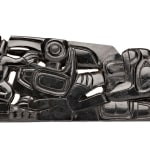-
Artworks
UNIDENTIFIED HAIDA ARTIST
Panel Pipe, c. 1850sargillite, 3.25 x 14.25 x 0.75 (8.3 x 36.2 x 1.9 cm)
unsigned.
LOT 48
ESTIMATE: $20,000 — $30,000
PRICE REALIZED: $22,800.00Further images
Between about 1830 and 1850, a new convention in argillite tobacco-pipe forms appeared and evolved into this type of narrow, tapered, highly pierced sculpture known today as a panel pipe....Between about 1830 and 1850, a new convention in argillite tobacco-pipe forms appeared and evolved into this type of narrow, tapered, highly pierced sculpture known today as a panel pipe. The word pipe is a bit of a misnomer, because, in many examples, including this one, the bowl of said pipe is quite small and a relatively long way from the small end of the panel and the exit of the smoke channel. No panel pipes of this kind appear to have been smoked, being created like most argillite works as an item for sale to the seaborn traders and explorers that arrived on the Northwest Coast, primarily from the eastern US and Britain. The more elaborate the decoration, the less functional the pipe became.
Beginning at the wider end, the figure lying on its back is possibly a thunderbird, based on its size and elaborate wings, or some other powerful avian. From its beak emerges a human figure, its head, arms and torso protruding. Perched as it were on the wings of the bird, its paws touching hands with the human, its snout touching the human’s jaw, is a flop-eared dog, whose coat is made up of randomized parallel grooves, short and sweeping in every direction.
Right behind the dog is a tall-eared half animal, half man of indeterminate identity. Touching the chin of the long-eared man creature, and held between his hands, is the tapering snout of a whale, or whale-like creature, with round eyes. The small bowl of the pipe is contained within this figure’s head. Large pectoral fins sweep down from a narrow attachment, and the body and tail extend behind the head. Beneath and seemingly supporting the whale-like figure is a reclining creature with clawed feet and the whale-tail held in its mouth. That figure rests upon a horizontal cylindrical form that extends along the base of the sculpture, the smoke channel running through it from this point to the narrow end of the pipe. A stack of hat rings forms one edge of the pipe in this section, crossing from the top of the head of the whale-tail biter to the bottom of the terminal figure at the end of the sculpture. Below that, appearing to emerge from the head of the tail-biter, is the head of another whale-like figure, its body and tail wrapped around the cylindrical form that carries the smoke channel. From the tip of that tail to the end of the pipe is a compact bird with a recurved beak, one indication of a thunderbird. A row of eight tail feathers extend down from below its chin, and its wings, elaborated with formline ovoid and U-shapes, sweep upward behind its head.
The two-dimensional design work on this pipe departs somewhat from the classical tradition, suggesting that it originated in a later time than many of the older, more classically embellished examples.
Steven C. Brown
One of the chief clues that this panel pipe has departed from tradition is the charming figure of the dog. Dogs appear regularly on Haida ship panel pipes, which were popular trade items in the 1840s and 1850s (see First Arts, December 2020, Lot 17). It’s interesting to see the borrowing of “Euro-American” imagery for a “traditional” Haida-style pipe; ship pipes occasionally incorporated traditional Haida figures as well.
References: For a more “classic” Haida style pipe from 1860, of similar size and very similar narrow trapezoidal shape, see Stephen C. Brown, Native Visions: Evolution in Northwest Coast Art from the Eighteenth through the Twentieth Century, (Seattle Art Museum, 1998), fig. 4.51, p. 97. For examples of Haida and ship penal pipes with “borrowed” imagery see Leslie Drew and Douglas Wilson, Argillite: Art of the Haida, (North Vancouver: Hancock House, 1980), pp. 163 and 173.Provenance
Private Collection, Montreal;
by descent to the Present Private Collection, Montreal.
Join our mailing list
* denotes required fields
We will process the personal data you have supplied in accordance with our privacy policy (available on request). You can unsubscribe or change your preferences at any time by clicking the link in our emails.






